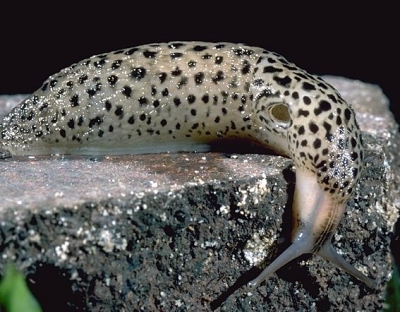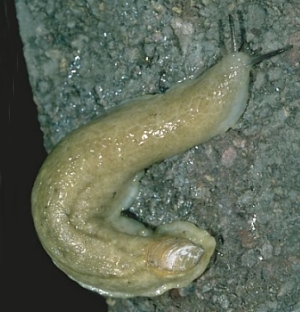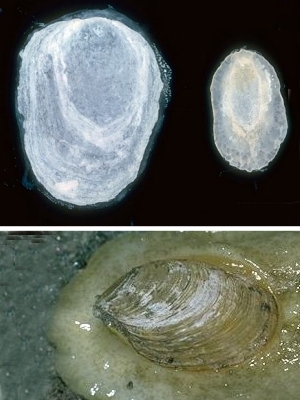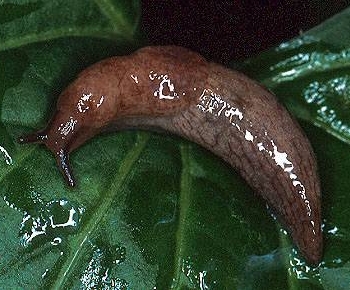
Land Slugs - Introduction
PHOTO
Upper right: The Leopard Slug, Limax maximus [Fam: Limacidae]. A large northern European slug which has followed humans to most parts of the world. Lower left: Another northern European slug, Testacella haliotoidea, [Fam: Testacellidae] which has also colonised much of the world. Lower right: Internal shells of two limacid slugs [upper] and external shell of Testacella [lower]. Photos: Bill Rudman
Land Slugs have evolved from Land Snails not Sea Slugs. The 'slug shape' is better thought of as a particular type of body design rather than a group of closely related animals. Living on land - out of water - is difficult for soft bodied animals such as molluscs, so for land snails, their shell has been an extremely valuable asset, providing a shelter in which they can hide from attack, and help them from drying out on hot and windy days. For reasons we still don't really understand many different snail families have evolved slug forms, in which the shell is gradually lost. Testacella is an example of a slug with an external shell, which is much reduced in size, is no longer calcified, and can have little practical use. In Limax, on the other hand, the shell is a reduced flattened calcareous internal plate.
The hole in the side of the body of Limax is the pneumostome, a breathing hole which opens and closes as air is drawn into the lung. The 'lung' is a modification of the mantle cavity found in snails. Slugs are usually disliked because of their slimy feel, cause by the copious mucus they secrete from skin glands. This slime is vitally important for slugs as it is valuable in providing then with a smooth path to crawl along, and to prevent them from drying out.
See
Land slugs - the Semi-slugs
Land Slugs - eggs & development


Rudman, W.B., 2006 (June 14) Land Slugs - Introduction. [In] Sea Slug Forum. Australian Museum, Sydney. Available from http://www.seaslugforum.net/find/landslugs01
Related messages
Land slugs and salt
August 28, 2006
From: Dave Sigworth
I can't seem to find this question asked /answered previously on your web site so pardon me if I'm asking you to repeat yourselves, but ....
If I pour salt on a garden slug to kill it, how is it that sea slugs live in salt water? Is it due to some similar difference between freshwater fish and marine fish?
Dave Sigworth
BartSig@comcast.net
Sigworth, D., 2006 (Aug 28) Land slugs and salt. [Message in] Sea Slug Forum. Australian Museum, Sydney. Available from http://www.seaslugforum.net/find/17594Dear Dave,
I'll try and give you a short uncomplicated version of what is quite a complex physiological story.
Firstly, all life on land has evolved from the sea. Body fluids, such as blood, have much the same salt concentration as sea water, because the primitive animals we evolved from weren't very good at stopping salts and water in the sea water passing in and out of their bodies through their skin. Which brings us to a physical phenomenon called osmosis. If you put salty water of two different salt concentrations together, water from the less salty solution will move to the saltier solution until they are both the same saltiness. Now, if we use freshwater fish as an example, their blood and body fluids are much 'saltier' than freshwater. If osmosis was allowed to occur, their bodies would be flooded with freshwater rushing in to lower the salt concentration so that it matched the surrounding freshwater. In effect the fish would inflate with freshwater and burst! However freshwater fish have evolved ways of preventing this - skin that doesn't allow water through easily, and kidneys that can pump excess water out - a bit like a boat's bilge pumps.
Which brings us back to land slugs. They have an even greater problem because they live out of water and their skin is not particularly good at preventing water movement in and out. That is why in air they have to be careful to stay damp so they don't dry out. That is one of the reasons they are most active at night, and why they secrete 'slime' from skin glands..
Now to the salt treatment. In terms of osmosis, damp salt is a very highly concentrated solution, so when salt is placed on a land slug, water from inside the slug quickly moves out through the skin to try and balance the salt concentration inside and outside the body. The result is that most of the water is sucked out of the slug and it dies. Sea Slugs and land slugs have much the same salt concentration in their blood as sea water, so Sea Slugs in sea water are ok. However if you keep sea slugs in an aquarium, and you don't look after the aquarium, often water will evaporate and the salt concentration in the aquarium water will rise and the animals will die. Not quite as dramatic has covering a slug with salt, but the same basic principle.
Best wishes,
Bill Rudman
Do slugs all live in sea water?
June 17, 2006
From: Song Xikun

Dear Bill,
Those days in Xiamen, it has rained for more than one month. I often see these disgusting animals in trees or on stones in our campus. It looks like a sea slug in morphology, but not as beautiful.
If this is a slug, what is it? Another question is whether land snails also have a veliger larval stage for dispersal?
Thank you!
Song Xikun
xksong@xmu.edu.cn
Song, X.K., 2006 (Jun 17) Do slugs all live in sea water?. [Message in] Sea Slug Forum. Australian Museum, Sydney. Available from http://www.seaslugforum.net/find/16830Dear Song,
Modern studies of Gastropod evolution consider that land snails and land slugs [Pulmonata] and the Sea slugs [Opisthobranchia] are closely related in a clade called the Heterobranchia. This clade also contains a few problematic 'snail' groups including the Valvatoidea, Architectonicoidea, Risoelloidea and the Pyramidelloidea. There are a number of anatomical features which link these groups together which I won't go into here. Suffice to say that Land snails, Land slugs and Sea slugs are closely related to each other but we cannot say that Land slugs evolved from Sea slugs. The slug form is a 'shape' or grade of evolutionary development which has occurred many times in the molluscs, but in each case the 'slug' has evolved from a 'snail' through the reduction in size and gradual loss of the shell.
So the land slugs you see around your campus have evolved from land snails. Like land snails they have had to evolve ways to live out of water.. The reason you see more around during very wet weather is that since they have evolved to live out of water, they are now unable to live in water, and so are probably having to abandon their normal 'home' in the soil or under rocks, or they will drown! Concerning eggs and development. Land snails could only become true land dwellers if their eggs and larvae were able to develop out of water. So today Land snails and Land slugs have what is called intracapsular direct development, where the larvae develop within the egg capsule and hatch out as small crawling snails or slugs.
I have prepared a few pages to illustrate some of these points.
Land slugs - Introduction
Land slugs - the Semi-slugs
Land Slugs - eggs & development
Best wishes,
Bill Rudman
